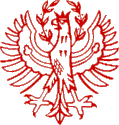South Tyrolean Schützenbund
| South Tyrolean Schützenbund (SSB) |
|
|---|---|

|
|
| legal form | Registered association |
| founding | March 2, 1958
|
| place |
Bolzano (administrative center) Italy |
| president |
State Commander Jürgen Wirth Anderlan |
| Members | 5,068 |
| Website | www.schuetzen.com |
The Südtiroler Schützenbund (SSB) was founded on March 2nd, 1958 in Bolzano in South Tyrol , but is based on older principles. The federal government currently consists of 141 member companies and 3 shooting bands , which include around 5,100 shooters and sutlers .
history
In the Tyrolean area there were rifle clubs since the late Middle Ages , which were formed in the regional courts and in the towns of the former county - for example in Bozen as early as 1488 - and were held mainly for defense purposes. This was also contractually fixed in the so-called Landlibell of 1511 .
The riflemen became known nationwide due to the Tyrolean uprising of 1809/10 and were also used in the Risorgimento battles in the border regions of Trentino and Lombardy.
During the First World War , these formations were also used as standing riflemen in the war of aggression and defense, especially on the eastern and southern fronts.
After the Austro-Hungarian defeat of the war in 1918 and the annexation of South Tyrol by the Kingdom of Italy in 1919, shooting was gradually banned and completely banned from the public under fascism from 1922.
The rifle system was reactivated during the National Socialist occupation of South Tyrol in 1943/45, functionalized in line with the regime and also actively integrated into the Volkssturm in October 1944 by the Tyrolean Gauleiter Franz Hofer . After the liberation from Nazi fascism in 1945, the Italian ban was renewed before it was re-established in 1958.
Purpose of the Schützenbund
Purpose of the federal government (see statutes of the SSB dated June 1, 2002) and the rifle companies and rifle bands affiliated to it are:
- "Faithfulness to God, adherence to the Christian faith and the spiritual and cultural heritage of the ancestors,
- the protection of the homeland and the Tyrolean way of life and nature,
- the unity of the state of Tyrol , the exemplary exercise of the rights and obligations of the South Tyroleans to maintain the Tyrolean character and to secure the livelihood of the German and Ladin ethnic groups in their ancestral homeland,
- human freedom and dignity,
- the care of the Tyrolean rifle custom, the local costumes and the local landscape and nature. "
Structure and organs of the SSB
The Schützenbund is divided into districts ( Unterland , Wipptal , Pustertal , Brixen , Burggrafenamt , Vinschgau , Bozen). Each rifle company or chapel is assigned to one of these districts. Within the companies a distinction is made between active, supportive and honorary members.
The SSB also consists of the following bodies:
A) The Federal Administration (BL) consists of:
- State Commander
- Deputy State Commander
- Federal Managing Director
- Federal Treasurer
- Country Curate
- 7 district majors
- Speakers
- Representatives of the Ladin companies
- Federal Secretary
- Adjutant to the state commander
B) Federal Committee (BA)
- Members of the federal management
- Battalion commanders
- Delegates, with each rifle district sending one officer-level delegate elected by them for every five companies.
Personalities
- Alois Pupp (1900–1969), South Tyrolean governor and former regional commander of the SSB
- Georg Klotz (1919–1976), South Tyrolean separatist and former deputy regional commander of the SSB
- Karl Mitterdorfer (1920–2017), German fighter pilot, former state commander of the SSB and politician
- Paul Bacher (* 1937), former sports functionary and state commander of the SSB
- Luis Amplatz (1926–1964), South Tyrolean separatist, murder victim and officer of the rifle company "Major Josef Eisensteck" Gries
- Bruno Hosp (* 1938), politician and former state commander of the SSB
- Luis Durnwalder (* 1941), South Tyrolean governor and honorary member of the Brixen shooting district
- Siegfried de Rachewiltz (* 1947), ethnologist, cultural historian, writer from South Tyrol and former cultural advisor at the SSB
- Michl Ebner (* 1952), entrepreneur, publisher, author, politician and former federal major
- Pius Leitner (* 1954), politician and former state commander of the SSB
- Peter Paul Rainer (* 1967), former politician and education and culture advisor at the SSB
Web links
literature
- Reinhard Olt : Steadfast in the headwind - The South Tyrolean Schützenbund and its work for Tyrol as a whole. Verlag Effekt GmbH, Neumarkt ad Etsch 2017, ISBN 978-88-97053-39-2 .
- Elisabeth Tauber: The “moving out” of the South Tyrolean riflemen - a ritual of public space. An ethnographic-anthropological approach . In: Hannes Obermair u. a. (Ed.): Regional civil society in motion. Festschrift for Hans Heiss (= Cittadini innanzi tutto ). Folio Verlag, Vienna-Bozen 2012, ISBN 978-3-85256-618-4 , p. 52-67 .
Individual evidence
- ↑ Hannes Obermair: Written form and documented tradition of the city of Bozen up to 1500 - patterns, forms, typologies (= »cristallîn wort«. Hartmann studies . Volume 1 ). LIT Verlag, Münster 2008, ISBN 978-3-8258-1097-9 , pp. 33-58, reference p. 48 , doi : 10.13140 / RG.2.1.1126.1204 .
- ^ Franz Huter : 450 years of the Tyrolean military constitution. The Landlibell from 1511. A landmark and memorial of military capacity and freedom of defense. In: Tyrolean homeland . 25, 1961, ISSN 1013-8919 , pp. 137-142.
- ↑ See the report with photos in the Bozner Tagblatt , October 21, 1944, p. 3.
- ↑ Statutes of the South Tyrolean Shooting Association , schuetzen.com. Retrieved May 7, 2015.
- ↑ The rifle companies , schuetzen.com. Retrieved May 7, 2015.
Coordinates: 46 ° 29 ′ 53.9 ″ N , 11 ° 21 ′ 29.1 ″ E
